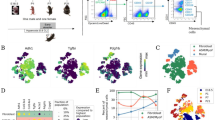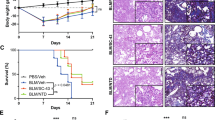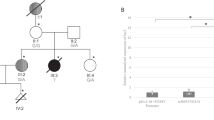Abstract
Background:
Stem cell factor (SCF) and its receptor, c-kit, are modulators of angiogenesis. Neonatal hyperoxia-induced lung injury (HILI) is characterized by disordered angiogenesis. The objective of this study was to determine whether exogenous SCF improves recovery from neonatal HILI by improving angiogenesis.
Methods:
Newborn rats assigned to normoxia (RA: 20.9% O2) or hyperoxia (90% O2) from postnatal day (P) 2 to 15, received daily injections of SCF 100 μg/kg or placebo (PL) from P15 to P21. Lung morphometry was performed at P28. Capillary tube formation in SCF-treated hyperoxia-exposed pulmonary microvascular endothelial cells (HPMECs) was determined by Matrigel assay.
Results:
As compared with RA, hyperoxic-PL pups had decrease in alveolarization and in lung vascular density, and this was associated with increased right ventricular systolic pressure (RVSP), right ventricular hypertrophy, and vascular remodeling. In contrast, SCF-treated hyperoxic pups had increased angiogenesis, improved alveolarization, and attenuation of pulmonary hypertension as evidenced by decreased RVSP, right ventricular hypertrophy, and vascular remodeling. Moreover, in an in vitro model, SCF increased capillary tube formation in hyperoxia-exposed HPMECs.
Conclusion:
Exogenous SCF restores alveolar and vascular structure in neonatal rats with HILI by promoting neoangiogenesis. These findings suggest a new strategy to treat lung diseases characterized by dysangiogenesis.
Similar content being viewed by others
Log in or create a free account to read this content
Gain free access to this article, as well as selected content from this journal and more on nature.com
or
References
Jobe AH, Bancalari E . Bronchopulmonary dysplasia. Am J Respir Crit Care Med 2001;163:1723–9.
Baraldi E, Filippone M . Chronic lung disease after premature birth. N Engl J Med 2007;357:1946–55.
Khemani E, McElhinney DB, Rhein L, et al. Pulmonary artery hypertension in formerly premature infants with bronchopulmonary dysplasia: clinical features and outcomes in the surfactant era. Pediatrics 2007;120:1260–9.
Thébaud B, Abman SH . Bronchopulmonary dysplasia: where have all the vessels gone? Roles of angiogenic growth factors in chronic lung disease. Am J Respir Crit Care Med 2007;175:978–85.
Anderson DM, Williams DE, Tushinski R, et al. Alternate splicing of mRNAs encoding human mast cell growth factor and localization of the gene to chromosome 12q22-q24. Cell Growth Differ 1991;2:373–8.
Wen LP, Fahrni JA, Matsui S, Rosen GD . Airway epithelial cells produce stem cell factor. Biochim Biophys Acta 1996;1314:183–6.
Heinrich MC, Dooley DC, Freed AC, et al. Constitutive expression of steel factor gene by human stromal cells. Blood 1993;82:771–83.
Kajstura J, Rota M, Hall SR, et al. Evidence for human lung stem cells. N Engl J Med 2011;364:1795–806.
Lindsey JY, Ganguly K, Brass DM, et al. c-Kit is essential for alveolar maintenance and protection from emphysema-like disease in mice. Am J Respir Crit Care Med 2011;183:1644–52.
Papayannopoulou T, Brice M, Broudy VC, Zsebo KM . Isolation of c-kit receptor-expressing cells from bone marrow, peripheral blood, and fetal liver: functional properties and composite antigenic profile. Blood 1991;78:1403–12.
Lennartsson J, Rönnstrand L . Stem cell factor receptor/c-Kit: from basic science to clinical implications. Physiol Rev 2012;92:1619–49.
Bonikos DS, Bensch KG, Ludwin SK, Northway WH Jr . Oxygen toxicity in the newborn. The effect of prolonged 100 per cent O2 exposure on the lungs of newborn mice. Lab Invest 1975;32:619–35.
Shaffer SG, O’Neill D, Bradt SK, Thibeault DW . Chronic vascular pulmonary dysplasia associated with neonatal hyperoxia exposure in the rat. Pediatr Res 1987;21:14–20.
Sun L, Hui AM, Su Q, et al. Neuronal and glioma-derived stem cell factor induces angiogenesis within the brain. Cancer Cell 2006;9:287–300.
Matsui J, Wakabayashi T, Asada M, Yoshimatsu K, Okada M . Stem cell factor/c-kit signaling promotes the survival, migration, and capillary tube formation of human umbilical vein endothelial cells. J Biol Chem 2004;279:18600–7.
Fujii H, Sun Z, Li SH, et al. Ultrasound-targeted gene delivery induces angiogenesis after a myocardial infarction in mice. JACC Cardiovasc Imaging 2009;2:869–79.
Zhang W, Stoica G, Tasca SI, Kelly KA, Meininger CJ . Modulation of tumor angiogenesis by stem cell factor. Cancer Res 2000;60:6757–62.
Takakura N, Watanabe T, Suenobu S, et al. A role for hematopoietic stem cells in promoting angiogenesis. Cell 2000;102:199–209.
Fazel S, Cimini M, Chen L, et al. Cardioprotective c-kit+ cells are from the bone marrow and regulate the myocardial balance of angiogenic cytokines. J Clin Invest 2006;116:1865–77.
Sun L, Lee J, Fine HA . Neuronally expressed stem cell factor induces neural stem cell migration to areas of brain injury. J Clin Invest 2004;113:1364–74.
Litz J, Krystal GW . Imatinib inhibits c-Kit-induced hypoxia-inducible factor-1alpha activity and vascular endothelial growth factor expression in small cell lung cancer cells. Mol Cancer Ther 2006;5:1415–22.
Xiang FL, Lu X, Hammoud L, et al. Cardiomyocyte-specific overexpression of human stem cell factor improves cardiac function and survival after myocardial infarction in mice. Circulation 2009;120:1065–74, 9 p following 1074.
Elmasri H, Ghelfi E, Yu CW, et al. Endothelial cell-fatty acid binding protein 4 promotes angiogenesis: role of stem cell factor/c-kit pathway. Angiogenesis 2012;15:457–68.
Pedersen M, Löfstedt T, Sun J, Holmquist-Mengelbier L, Påhlman S, Rönnstrand L . Stem cell factor induces HIF-1alpha at normoxia in hematopoietic cells. Biochem Biophys Res Commun 2008;377:98–103.
Wang CH, Anderson N, Li SH, et al. Stem cell factor deficiency is vasculoprotective: unraveling a new therapeutic potential of imatinib mesylate. Circ Res 2006;99:617–25.
Simpson K, Hogaboam CM, Kunkel SL, Harrison DJ, Bone-Larson C, Lukacs NW . Stem cell factor attenuates liver damage in a murine model of acetaminophen-induced hepatic injury. Lab Invest 2003;83:199–206.
Bengatta S, Arnould C, Letavernier E, et al. MMP9 and SCF protect from apoptosis in acute kidney injury. J Am Soc Nephrol 2009;20:787–97.
Jungraithmayr W, De Meester I, Matheeussen V, Baerts L, Arni S, Weder W . CD26/DPP-4 inhibition recruits regenerative stem cells via stromal cell-derived factor-1 and beneficially influences ischaemia-reperfusion injury in mouse lung transplantation. Eur J Cardiothorac Surg 2012;41:1166–73.
Sutsko RP, Young KC, Ribeiro A, et al. Long-term reparative effects of mesenchymal stem cell therapy following neonatal hyperoxia-induced lung injury. Pediatr Res 2013;73:46–53.
Cheng M, Zhou J, Wu M, et al. CXCR4-mediated bone marrow progenitor cell maintenance and mobilization are modulated by c-kit activity. Circ Res 2010;107:1083–93.
Aono Y, Nishioka Y, Inayama M, et al. Imatinib as a novel antifibrotic agent in bleomycin-induced pulmonary fibrosis in mice. Am J Respir Crit Care Med 2005;171:1279–85.
Gambaryan N, Perros F, Montani D, Cohen-Kaminsky S, Mazmanian GM, Humbert M . Imatinib inhibits bone marrow-derived c-kit+ cell mobilisation in hypoxic pulmonary hypertension. Eur Respir J 2010;36:1209–11.
Kuonen F, Laurent J, Secondini C, et al. Inhibition of the Kit ligand/c-Kit axis attenuates metastasis in a mouse model mimicking local breast cancer relapse after radiotherapy. Clin Cancer Res 2012;18:4365–74.
Chang YS, Choi SJ, Ahn SY, et al. Timing of umbilical cord blood derived mesenchymal stem cells transplantation determines therapeutic efficacy in the neonatal hyperoxic lung injury. PLoS ONE 2013;8:e52419.
Norol F, Merlet P, Isnard R, et al. Influence of mobilized stem cells on myocardial infarct repair in a nonhuman primate model. Blood 2003;102:4361–8.
Young KC, Torres E, Hatzistergos KE, Hehre D, Suguihara C, Hare JM . Inhibition of the SDF-1/CXCR4 axis attenuates neonatal hypoxia-induced pulmonary hypertension. Circ Res 2009;104:1293–301.
Knudsen L, Weibel ER, Gundersen HJ, Weinstein FV, Ochs M . Assessment of air space size characteristics by intercept (chord) measurement: an accurate and efficient stereological approach. J Appl Physiol 2010;108:412–21.
Ochs M, Nyengaard JR, Jung A, et al. The number of alveoli in the human lung. Am J Respir Crit Care Med 2004;169:120–4.
Thébaud B, Ladha F, Michelakis ED, et al. Vascular endothelial growth factor gene therapy increases survival, promotes lung angiogenesis, and prevents alveolar damage in hyperoxia-induced lung injury: evidence that angiogenesis participates in alveolarization. Circulation 2005;112:2477–86.
Author information
Authors and Affiliations
Corresponding author
Rights and permissions
About this article
Cite this article
Miranda, L., Rodrigues, C., Ramachandran, S. et al. Stem cell factor improves lung recovery in rats following neonatal hyperoxia-induced lung injury. Pediatr Res 74, 682–688 (2013). https://doi.org/10.1038/pr.2013.165
Received:
Accepted:
Published:
Issue date:
DOI: https://doi.org/10.1038/pr.2013.165
This article is cited by
-
Intra-tracheal administration of a naked plasmid expressing stromal derived factor-1 improves lung structure in rodents with experimental bronchopulmonary dysplasia
Respiratory Research (2019)
-
TNFα-stimulated protein 6 (TSG-6) reduces lung inflammation in an experimental model of bronchopulmonary dysplasia
Pediatric Research (2019)
-
Looking ahead: where to next for animal models of bronchopulmonary dysplasia?
Cell and Tissue Research (2017)
-
Antagonism of stem cell factor/c-kit signaling attenuates neonatal chronic hypoxia-induced pulmonary vascular remodeling
Pediatric Research (2016)



